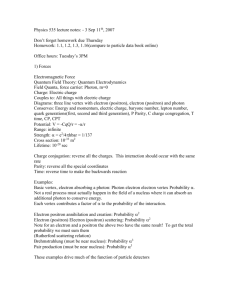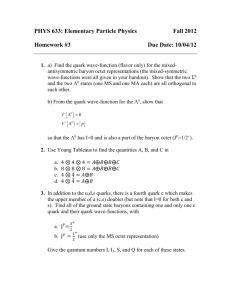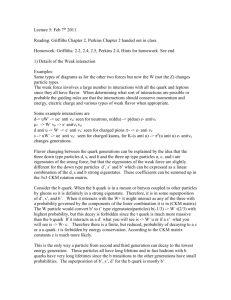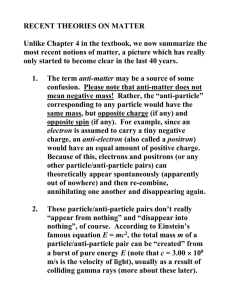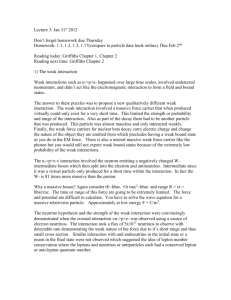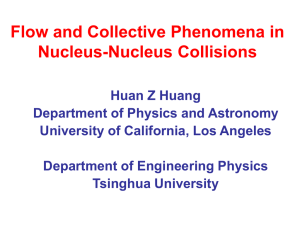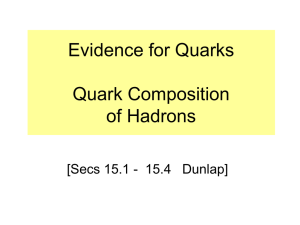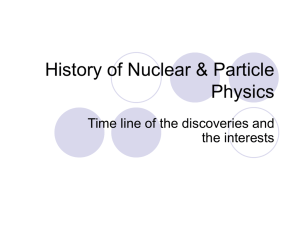lecturenotes2012_04
advertisement
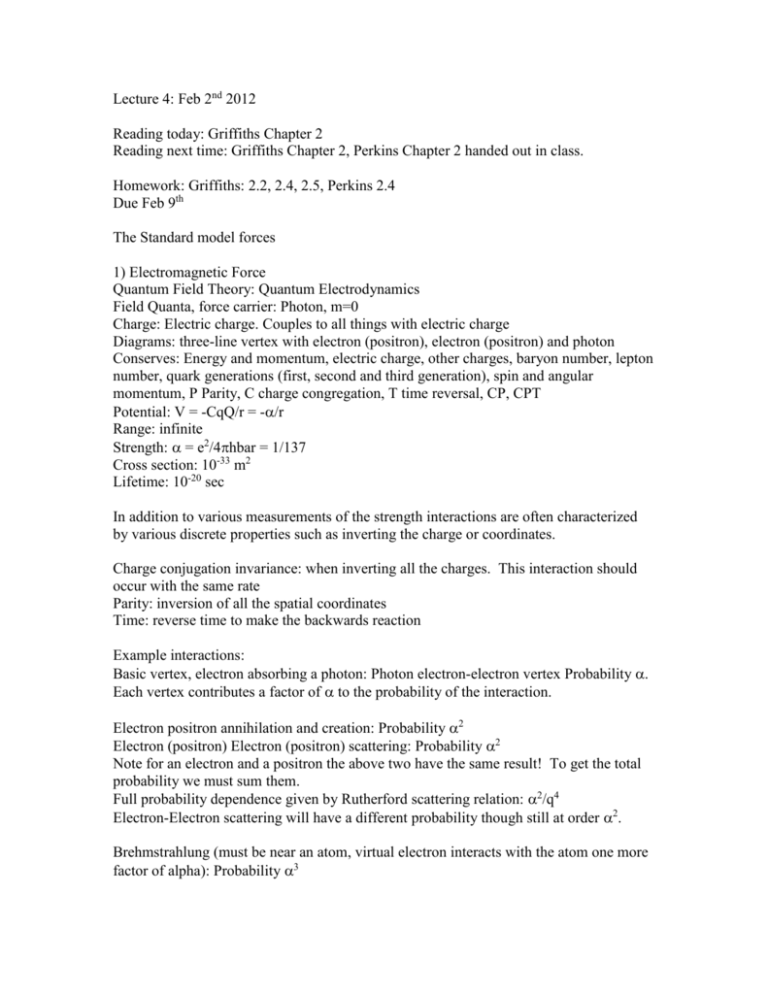
Lecture 4: Feb 2nd 2012 Reading today: Griffiths Chapter 2 Reading next time: Griffiths Chapter 2, Perkins Chapter 2 handed out in class. Homework: Griffiths: 2.2, 2.4, 2.5, Perkins 2.4 Due Feb 9th The Standard model forces 1) Electromagnetic Force Quantum Field Theory: Quantum Electrodynamics Field Quanta, force carrier: Photon, m=0 Charge: Electric charge. Couples to all things with electric charge Diagrams: three-line vertex with electron (positron), electron (positron) and photon Conserves: Energy and momentum, electric charge, other charges, baryon number, lepton number, quark generations (first, second and third generation), spin and angular momentum, P Parity, C charge congregation, T time reversal, CP, CPT Potential: V = -CqQ/r = -/r Range: infinite Strength: = e2/4hbar = 1/137 Cross section: 10-33 m2 Lifetime: 10-20 sec In addition to various measurements of the strength interactions are often characterized by various discrete properties such as inverting the charge or coordinates. Charge conjugation invariance: when inverting all the charges. This interaction should occur with the same rate Parity: inversion of all the spatial coordinates Time: reverse time to make the backwards reaction Example interactions: Basic vertex, electron absorbing a photon: Photon electron-electron vertex Probability . Each vertex contributes a factor of to the probability of the interaction. Electron positron annihilation and creation: Probability 2 Electron (positron) Electron (positron) scattering: Probability 2 Note for an electron and a positron the above two have the same result! To get the total probability we must sum them. Full probability dependence given by Rutherford scattering relation: 2/q4 Electron-Electron scattering will have a different probability though still at order 2. Brehmstrahlung (must be near an atom, virtual electron interacts with the atom one more factor of alpha): Probability 3 Pair production (must be near nucleus, virtual electron interacts with nucleus): Probability 3 Note on the single vertex process. Not a real process must actually happen in the field of a atom where it can absorb an additional photon to be relativistically allowed. Each vertex contributes a factor of to the probability of the interaction. In this case the interaction with the atom does not contribute a factor of alpha since the electron involved in such a process is orbiting very close to the nucleus and the probability of interaction with the nucleus in a reasonable time period is essentially one. These examples drive much of the function of particle detectors An interesting property: The virtual photons radiating from a charged particle can split into electrons and positrons and then annihilate back to a photon. These charges will orient with the positron toward the original charge (if negative) and the electron away from the charge. This effect, which is like a dielectric medium, tends to screen the original charge. As a result the effective coupling constant changes, becoming larger depending on how close you get to the original charge and smaller further away. We would say the coupling constant runs. 2) Strong Force Quantum Field Theory: Quantum Chromo Dynamics Field Quanta, force carrier: 8 gluons , m=0 Charge: red green and blue color charge, 8 gluons carry different combinations of color anti-color Couples to: quarks and gluons Diagrams: three line vertex with quark (anti quark), quark (anti quark) and gluon, or three gluons Conserves: Energy and momentum, electric charge, color charge, other charges(lepton number quark flavor/generation), baryon number, spin and angular momentum, C, P, T, CP, CPT Potential: V =- s/r + kr Range 10-15 m – by confinement of color neutral combinations Strength: s = 1.3 (1.3 at 0.217GeV low energy, 0.3 at 1 GeV mid energy, 0.1 at 100 GeV high energy) (EM 1/137) Cross section: 10-30 m2 (EM 10-33) Lifetime: 10-23 sec (EM 10-20 sec) Examples Strong quark annihilation… Note quark annihilation would also have a contribution from the electromagnetic force but it is so small compared to the strong contribution that it can usually be ignored. Scattering via a gluon These interactions explain the behavior of hadrons in dense matter particle detectors. Interesting effects. Virtual gluons can split into quarks or gluons and annihilate back to gluons. This effect tends to anti-screen. A bare quark would radiate a strong color field attracting other quarks. Until you have 3 (red green blue) or 2 (color anti-color) you don’t have a stable color neutral system. In fact as small distances inside hadrons the strength of the strong force is very small. Small enough that perturbation theory works and in fact quark inside a nucleon are essentially free – asymptotic freedom. As you get very close to the quark(takes very small wavelengths or high energy) the coupling constant get very small. Near EM level. A hint of Unification? If momentum is transferred to one of the quarks in this system the kr part of the potential will pull back the quark back. In terms of a potential this can be thought of as due to the strong color field. If the quark has enough momentum the gluon string between the quarks will build up enough energy to form two new quarks. The new configuration of two new quark and shorter gluon strings has a lower potential. Note: nucleons are held together by the residual color charge just as molecules are held together by the residual electric charge outside of the otherwise electrically neutral atoms. 3) Weak Force Quantum Field Theory: Quantum Flavor dynamics Field Quanta, force carrier: W+ and W- m=81GeV and Z m=91GeV Charge: Weak flavor charge. Lepton number, quark flavor Couples to: All things with flavor charge (all the quarks and leptons) Diagrams: W, three line vertex with electron neutrino and W or quark quark and W. Three line vertex with lepton (anti)-lepton or quark (anti)-quark and Z. Conserves: Energy and momentum, electric charge, lepton number, color charge, baryon number, CPT Violates: quark generation (W only, no flavor changing neutral current involving the neutral Z), C, P, CP(at a very small level) Potential: V = -W/r = -/M(W,Z)2r. Another hint of Unification Range: 10-18 Strength: W = 10-5(EM 1/137) Cross section: 10-44 m2(EM 10-33) Lifetime: 10-8 sec or longer EM 10-20 sec) Examples: Same types of diagrams as for the other two forces but now the W (not the Z) changes particle types. The weak force involves a large number in interactions with all the quark and leptons since they all have flavor. When determining what sort of interactions are possible or probable the guiding rules are that the interactions should conserve momentum and energy, electric charge and various types of weak flavor when appropriate. Some example interactions are d-> uW- -> ue- anti e: seen for neutrons, n(ddu) -> p(duu) e- antie - -> W- -> e- anite d anti u -> W- -> e- anti e: seen for charged pions - -> e- anti e s -> uW- -> ue- anti e: seen for charged kaons, for K-(s anti u) -> 0(u anit u) e- antie changes generations. Flavor changing between the quark generations can be explained by the idea that the three down type particles d, s, and b and the three up type particles u, c, and t are eigenstates of the strong force, but that the eigenstates of the weak force are slightly different for the down type particles d’, s’ and b’ which can be expressed as a linear combination of the d, s and b strong eigenstates. These coefficients can be summed up in the 3x3 CKM rotation matrix. Consider the b quark. When the b quark is in a meson or baryon coupled to other particles by gluons so it is definitely in a strong eigenstate. Therefore, it is in some superposition of d’, s’, and b’. When it interacts with the W+ it might interact as any of the three with a probability governed by the components of the linier combination it is in (CKM matrix) The W particle would convert b’ to t’ type eigenstates(particles) b(-1/3) -> W- t(2/3) with highest probability, but this decay is forbidden since the t quark is much more massive than the b quark If it interacts as a d’ what you will see is -> W- u or if a s’ what you will see is -> W- c. Therefore there is a finite probability of decaying to a c or a u quark. t is forbidden by energy conservation. According to the CKM matrix constants c is much more likely. This is the only way a particle from second and third generation can decay to the lowest energy generation. These particles all have long lifetime and in fact hadrons with b quarks have very long lifetimes since the b transitions to the other generations have small probabilities. The superposition of b’, s’, d’ for the b quark is mostly b’. The neutral Z particles have scattering and annihilation or pair production interactions much like the photons. Though these interactions can also involve neutrinos. Flavor changing between the generations like B->Zd is not possible for the Z particle. This can be understood mathematically. The W an interaction can be written as <u|WUCKM|s>, where a s strong eigenstate has some probability of being in a d’ weak eigenstate and being converted to a u quark. The matrix U is unitary because it conserves probability. For the Z, <d|U+ZU|s>, where U+ is the complex transform of U. However, U doesn’t act on the Z since it isn’t a quark and U+ZU = Z, and <d|Z|s> has zero probability since d and s are orthogonal eigenstates. Note FCNC, flavor changing neutral currents does happen at higher order at very low probability through higher order diagrams. Note that the weak boson couple to each other also but the interactions are very low probability so you don’t see them very often. They don’t lead to interesting new effects like in QCD. 4) Unification A milestone toward the standard model was the Z particle, the third quanta of the weak force. This particle was neutral and had similar interactions to the electromagnetic force such as e+e- -> Z -> e+e-. However it took a long time to find this particle since no one expected it! Any type of interaction involving the Z had an equivalent higher probability EM interaction, except for the neutrino interactions, which are very difficult to observe. Later it was seen that as you observed interactions such as particle-particle annihilation at higher and higher energies the constants that governed the electromagnetic and weak interactions changed and eventually unified at a high value. Essentially at energies well above the Z mass(91 times the proton mass) the mass of the carrier becomes irrelevant to the interaction. This was the first strong hint that there had to be some unifying theory behind all the diverse quantum field theories that had existed. Another way to put this is the both interactions have the same coupling constant and it’s just the extra factor of the mass of the gauge boson in the denominator that makes that gives the difference between the strengths of the interaction. Doing that calculation using the measured strength of the weak and electromagnetic interactions in similar configurations involving photons and Zs gives mZ=91GeV. Exactly what was later measured. Also a milestone for theory since it was predicted before it was found! In addition the strong force is seen to weaken at higher energies so it may also unify. One mystery in this picture is still present. Why do the W and Z have large mass. To explain this you need to introduce an additional particle that by coupling with particles can give them mass. This is the Higgs particle. The Higgs also gives mass to all the other massive particles. In fact the b, s and d states can be considered eigenstates of the Higgs interaction and the strong interaction. As before the b’, s’ and d’ states are still the Weak eigenstates. The Higgs particle interacts with any particle that has mass. Since these particles have mass they are in eigenstates of the Higgs particle (for instance when in a configuration where they have definite mass, such as a hadron). The neutrios, if they had no mass would be pure eigenstates of the Weak force. But since they do have some mass you can have interactions change lepton flavor generation just like with the quarks. These quantum field theories including the unified electroweak theory with the Higgs particle to explain the mass of the W and Z make up the standard model (SM).

